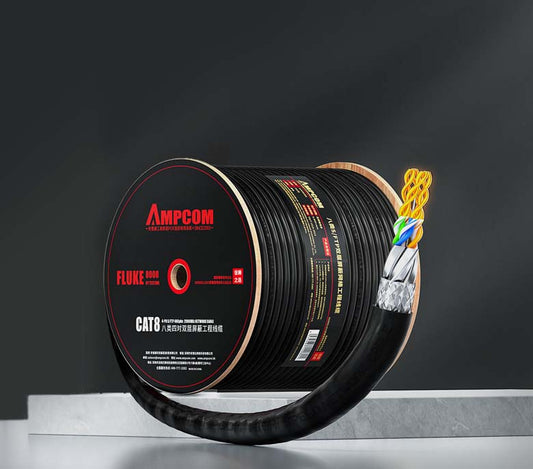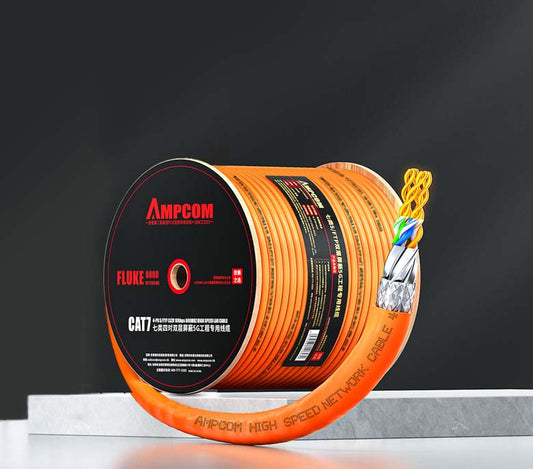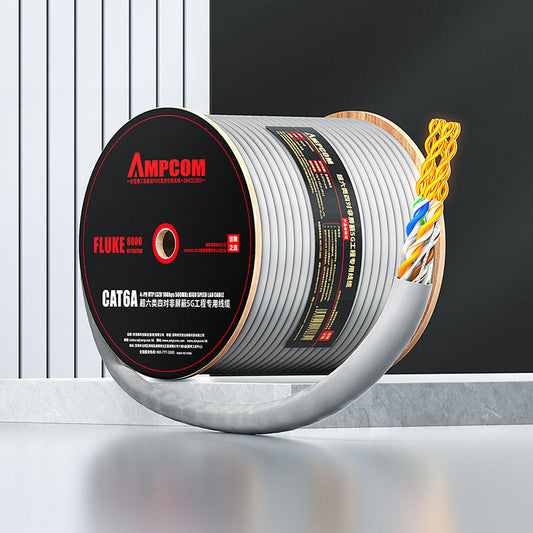Investment vs. Return: Evaluating the Value of Cat7/Cat8 Cables in Data Centers and HPC
Introduction
With the rapid development of technologies such as cloud computing, big data, artificial intelligence, and 5G, data centers and High-Performance Computing (HPC) environments face unprecedented challenges regarding network infrastructure. The volume of data is growing exponentially, and applications demand increasingly higher bandwidth, lower latency, and greater reliability. Against this backdrop, network cables rated Cat7 Patch Cable and Cat8 Patch Cable, due to their superior performance metrics, are increasingly appearing in these performance-critical scenarios. However, compared to Cat5e Patch Cable, Cat6 Patch Cable, and even Cat6a Patch Cable, the initial investment cost of Cat7 Patch Cable and Cat8 Patch Cable is significantly higher. So, in data centers and HPC environments, does the actual return brought by deploying these high-performance cables justify the high cost? This paper will delve into the value of Cat7/Cat8 cables in these key applications, evaluating the investment return from multiple dimensions such as performance improvement, future scalability, and operational efficiency.

1. Special Requirements for Network Cables in Data Centers and HPC Environments
Understanding the value of Cat7/Cat8 cables first requires clarifying the special requirements for network connectivity in data centers and HPC environments:
- Extremely High Bandwidth Needs: Modern data centers host applications like virtualization, containerization, and large-scale parallel computing. HPC clusters require rapid exchange of massive amounts of data. This demands network cables capable of supporting speeds from 10 Gigabit (10Gbps), 40 Gigabit (40Gbps), to 100 Gigabit (100Gbps), and even higher.
- Extremely Low Latency Requirements: Applications such as financial trading, real-time data analysis, and scientific simulations are highly sensitive to network latency. Microsecond-level differences in latency can impact business outcomes. As the physical medium for signal transmission, the inherent latency characteristics of the cable, as well as any interference it might introduce, affect overall latency.
- Excellent Immunity to Interference: Data centers have dense equipment and complex electromagnetic environments. High-performance computing nodes and storage devices within HPC clusters can also generate strong electromagnetic interference. Cables need strong immunity to ensure clean and stable signal transmission.
- Reliability and Stability: Network outages can lead to service unavailability, failed computing tasks, and significant losses. As the "last mile" of network connectivity, the reliability of cables is crucial, requiring high durability and a low failure rate.
- Future Scalability: Technology evolves rapidly, and network demands continue to grow. When deploying network infrastructure, future expansion needs over the next few years must be considered to avoid premature obsolescence.
- From Twisted Pair to Data Centers: The Evolution of Patch Cord Categories and Their Synergy with Data Center Architecture
2. Performance Advantages of Cat7/Cat8 Cables and Their Direct Value
Cat7 and Cat8 cables are designed to meet these stringent requirements. Their core performance advantages directly translate into value in data centers and HPC environments:
-
Support for Higher Speeds, Unlocking Application Potential:
- Cat7: Supports a maximum bandwidth of 600 MHz, far exceeding Cat6a's 500 MHz. Although its standard rate is also 10 Gigabit (10GBASE-T), the higher bandwidth means it can provide more stable and reliable 10 Gigabit performance over longer distances (like 100 meters) or in complex electromagnetic environments. For scenarios requiring stable 10 Gigabit connections in complex environments, Cat7 offers a more secure choice.
- Cat8: Specifically designed for high-speed internal connections in data centers, supporting up to 2000 MHz bandwidth. Standard rates reach 25GBASE-T/40GBASE-T, and can even support 100GBASE-T (over shorter distances). For rack-to-rack or intra-rack connections requiring 40G or 100G networks, Cat8 is the ideal choice. It directly supports larger data block transfers, faster model training, lower latency trading, and significantly improves compute and storage efficiency, shortening task completion times and directly boosting business output.
- Excellent Immunity to Interference, Ensuring Network Stability: Cat7 and Cat8 cables typically employ fully shielded designs (such as S/FTP, meaning each pair is individually shielded plus overall shielding, or SF/FTP). This design effectively combats external electromagnetic interference (EMI) and reduces crosstalk generated by the cable itself. Within complex electromagnetic environments in server racks, using Cat7/Cat8 cables can significantly reduce packet loss and retransmissions caused by interference, ensuring data transmission integrity. This improves network availability and reduces business interruptions or computing failures due to network issues.
- Lower Latency (Potential Advantage): While the latency contribution of the cable itself is relatively small, high-performance cables usually have better cable structures and lower transmission loss. In ultra-high-speed networks, any tiny latency optimization can accumulate into a noticeable advantage. Cat8 cables are designed and manufactured with greater emphasis on reducing signal distortion and latency, helping to achieve lower end-to-end network latency.
- Meeting Future Needs, Extending Investment Lifespan: Deploying Cat7/Cat8 cables can be seen as an "investment in future network needs." As application bandwidth demands continue to grow, Cat6a cables deployed today may quickly become a bottleneck. Cat8 cables can easily handle 40G/100G demands for the next few years and even lay the groundwork for early deployment of higher speeds (like 200G/400G), typically paired with DACs or AOCs. This avoids the need for repeated investment in replacing cables due to insufficient performance in the short term, extends the overall lifespan of the network infrastructure, and lowers the long-term Total Cost of Ownership (TCO).

From "Chaos" to "Order": The Importance and Best Practices of Data Center Cable Management
3. Cost Considerations: More Than Just the Cable Itself
Evaluating the return on investment for Cat7/Cat8 cables cannot focus solely on the purchase cost of the cables themselves; other related factors must also be considered:
- Cable Cost: Cat7 cable costs are typically higher than Cat6a, and Cat8 cable costs are even higher, potentially several times that of Cat6a. This is the most direct incremental cost.
- Connector Cost: Cat7/Cat8 cables often require higher-performance RJ45 connectors (or specifically designed connectors), which are more expensive than standard connectors.
- Termination Cost: Termination for Cat6a and above cables requires very high craftsmanship, especially for Cat8. It may require more skilled installation personnel, more precise tools, or even pre-terminated solutions like plug-and-play options, all of which increase installation costs. If professional service providers perform the installation, the labor costs for Cat7/Cat8 will also be higher.
- Compatibility Cost: Ensuring compatibility between the cables and the interfaces on both ends of the devices. High-end equipment usually supports interfaces with higher standards, but if the device interfaces are of a lower standard, additional converters or adapters may be needed, increasing costs and potential failure points.
- Management Cost: High-performance cables may require stricter management and testing procedures to ensure their performance is fully utilized and maintained long-term.
4. Return Analysis: Performance Gains and Efficiency Improvements
Despite the higher initial investment, the returns brought by Cat7/Cat8 cables in data center and HPC environments are often more significant:
- Enhanced Compute and Storage Efficiency: Higher bandwidth and lower latency mean data can flow more quickly between compute nodes, storage systems, and the network. For HPC applications, this means faster I/O speeds, enabling the processing of larger datasets and shorter simulation and computation times. For data center applications, it means faster data migration, backup, and recovery, improved virtual machine migration efficiency, and faster application deployment speeds.
- Improved Network Reliability and Availability: Excellent immunity to interference and stable performance reduce the risk of network failures and outages. High availability is critical for data centers and HPC clusters running 24/7, directly impacting business continuity and the completion rate of research tasks. Reducing troubleshooting and recovery time also indirectly improves operational efficiency.
- Support for More Dense Server Deployments: As server and network interface densities increase, the electromagnetic environment within server racks deteriorates. The shielding performance of Cat7/Cat8 cables helps maintain network performance under high-density deployments, supporting more compact and efficient data center designs.
- Simplified Network Architecture (Potential): In some scenarios, using higher-performance cables might allow simplifying the network hierarchy (e.g., reducing the number of switch layers) or supporting more flexible network topologies, potentially lowering some network equipment costs or simplifying management.
- Meeting Compliance and Security Requirements: Certain applications with extremely high data security requirements (such as finance and government) may have specific requirements for the physical layer's immunity to interference and confidentiality. The fully shielded characteristics of Cat7/Cat8 help meet these physical security needs.
- Standards and Specifications: Installation Practices and Acceptance Criteria for Cat5e to Cat8 Patch Cables

5. Value Assessment: When to Choose Cat7/Cat8?
Not all data centers or HPC environments necessarily need to choose Cat7/Cat8 cables. Their value needs to be evaluated based on specific scenarios:
-
Scenarios for Choosing Cat7:
- Requires stable 10 Gigabit connections, but the electromagnetic interference environment is relatively complex, making Cat6a performance insufficiently reliable.
- Plans to upgrade to 10 Gigabit within the next 1-3 years and hopes the existing cables can transition smoothly.
- Has extremely high requirements for network reliability and is willing to pay a premium for better interference immunity.
-
Scenarios for Choosing Cat8:
- Clearly needs to deploy 40G or 100G networks, especially for short-distance connections within or between racks.
- Runs applications extremely sensitive to bandwidth and latency, such as HPC, real-time financial trading, and large-scale AI model training.
- Data center planning cycles are long, and there's a desire for network infrastructure that can support high-speed demands for the next 5-10 years.
- Pursues ultimate network performance and future scalability and is willing to bear a higher initial investment.
-
Scenarios Where Cat7/Cat8 May Not Be Necessary:
- Only requires Gigabit or Fast Ethernet networks; Cat5e/Cat6 is sufficient.
- Has a clear 10 Gigabit network requirement, but the environment has minimal interference, Cat6a meets the requirements, and the budget is limited.
- Has low requirements for network performance; cost-sensitive applications.
- Standard Evolution and Ecosystem Impact: The Shaping of Network Ecosystem by Cat5e to Cat8 Cable Technology Development
6. Conclusion: A Wise Investment, the Foundation for Future-Ready Networks
Cat7 and Cat8 cables represent the forefront of network connectivity in data centers and HPC environments. The high bandwidth, low latency, strong anti-interference ability, and future scalability they provide can be directly translated into improving computing efficiency, enhancing network reliability, and ensuring business continuity. Although the initial investment cost is significantly higher than traditional cables, in high-performance computing and large-scale data center scenarios, this investment often generates significant or even exceeding returns. Their value lies in accelerating scientific research, improving business decision-making speed, and ensuring the operation of key business functions. Therefore, evaluating the value of Cat7/Cat8 cables should not be limited to cost levels alone; They should be seen as strategic investments in network infrastructure performance and future scalability. For data centers and HPC environments that pursue excellent performance, require long-term stable operation, and have clear predictions of future network requirements, Cat7/Cat8 cables are undoubtedly a wise choice for building high-performance and high reliability network foundations. The key is to accurately assess your own needs, conduct a comprehensive cost-benefit analysis, and make the most appropriate technical decisions for your situation.



